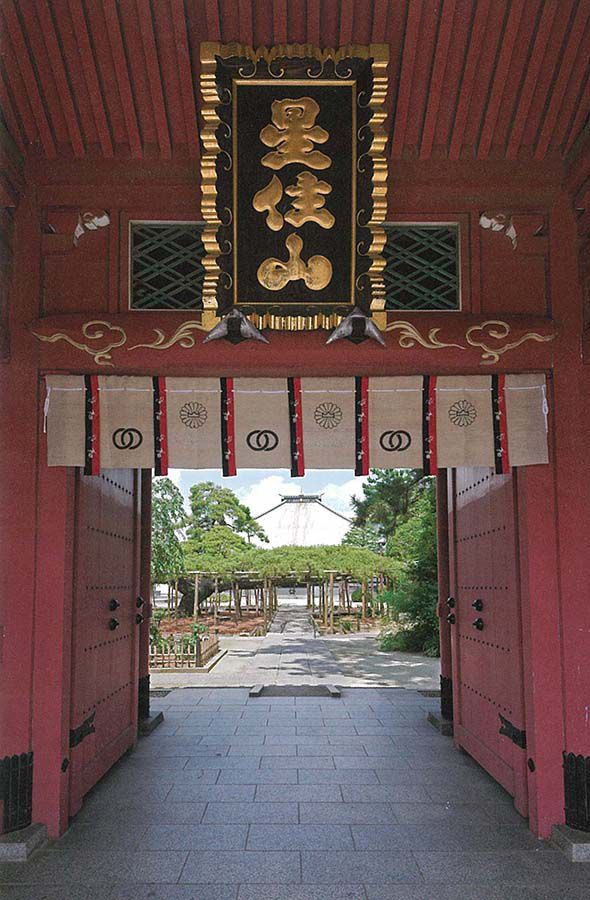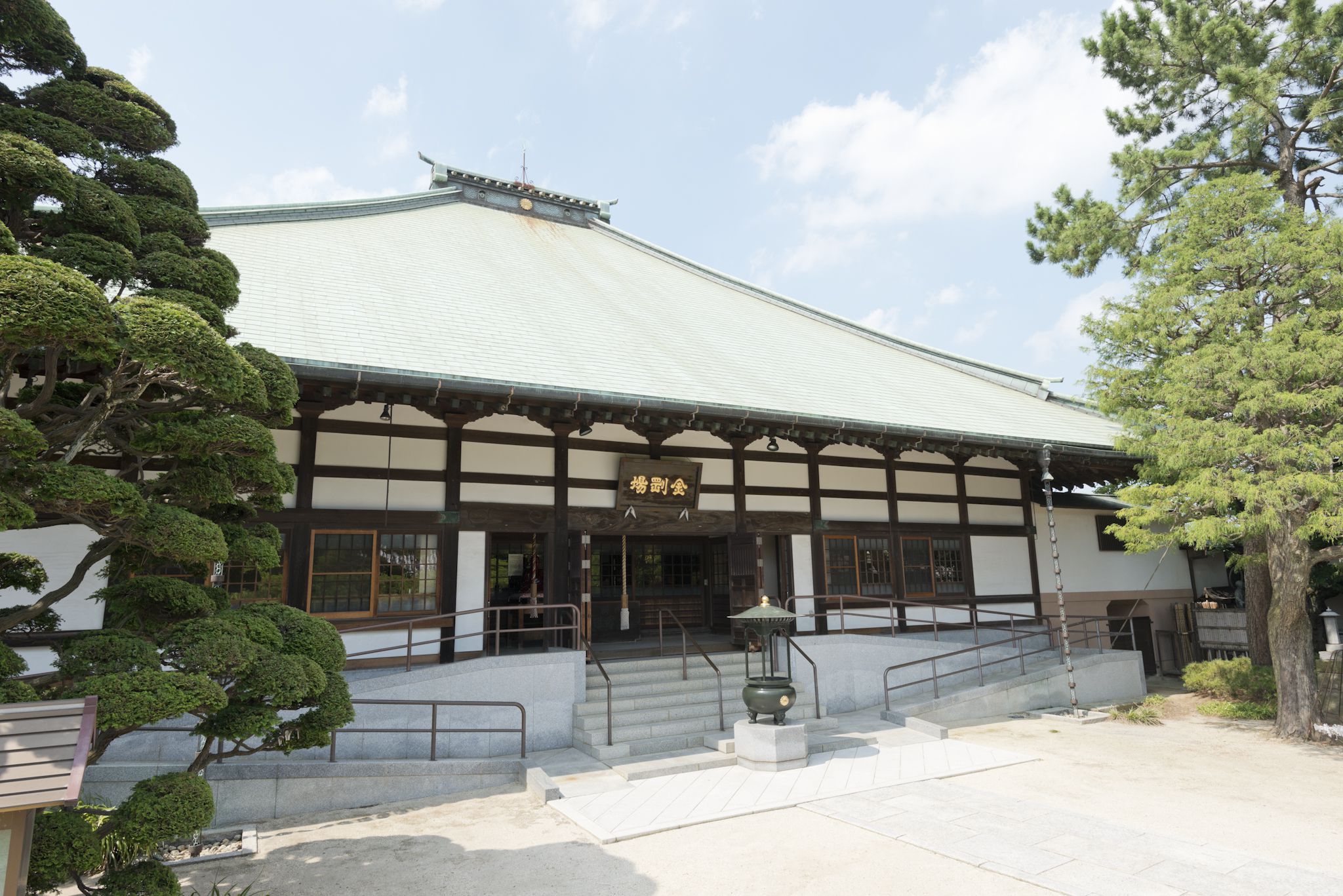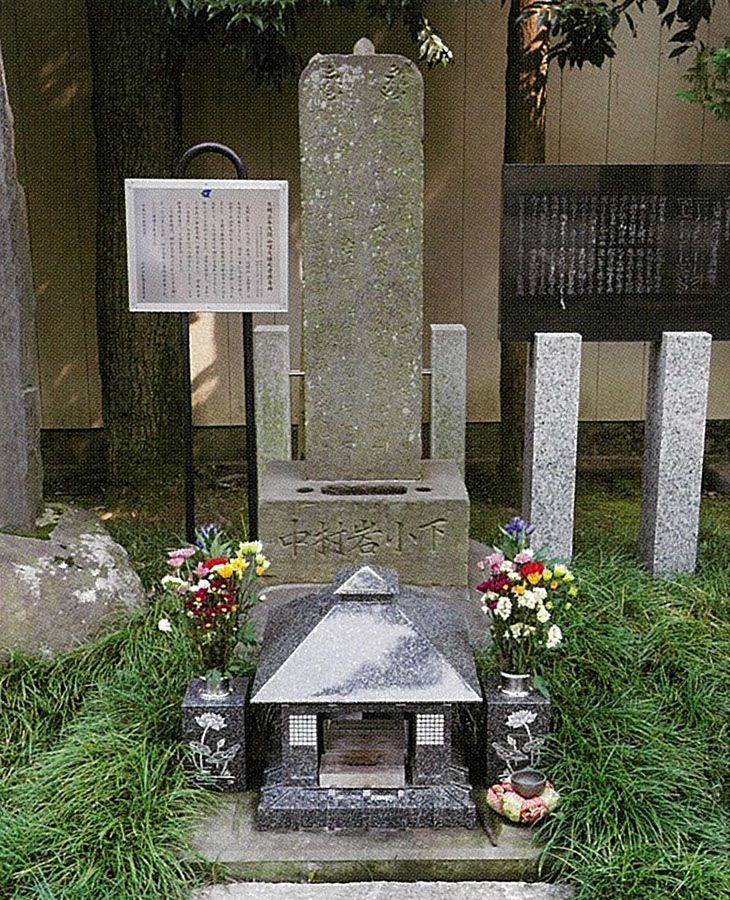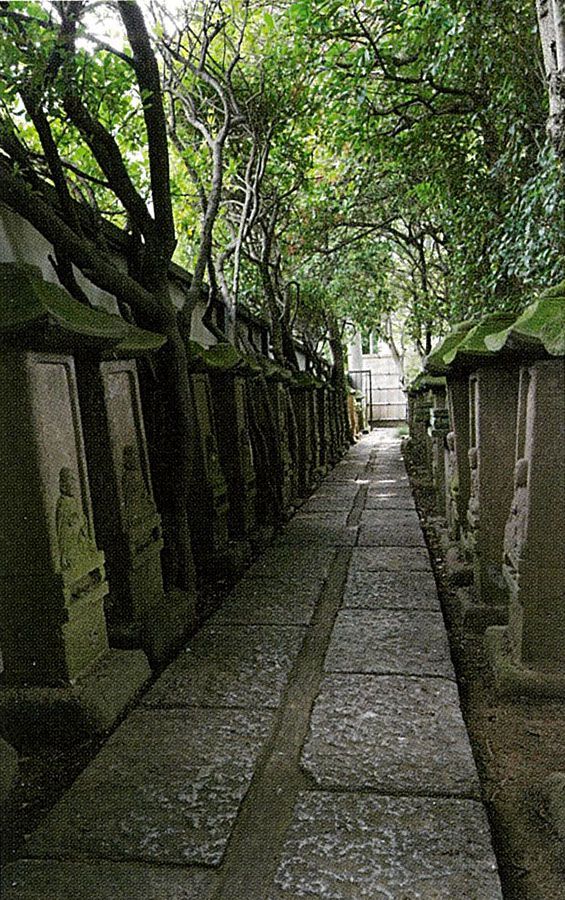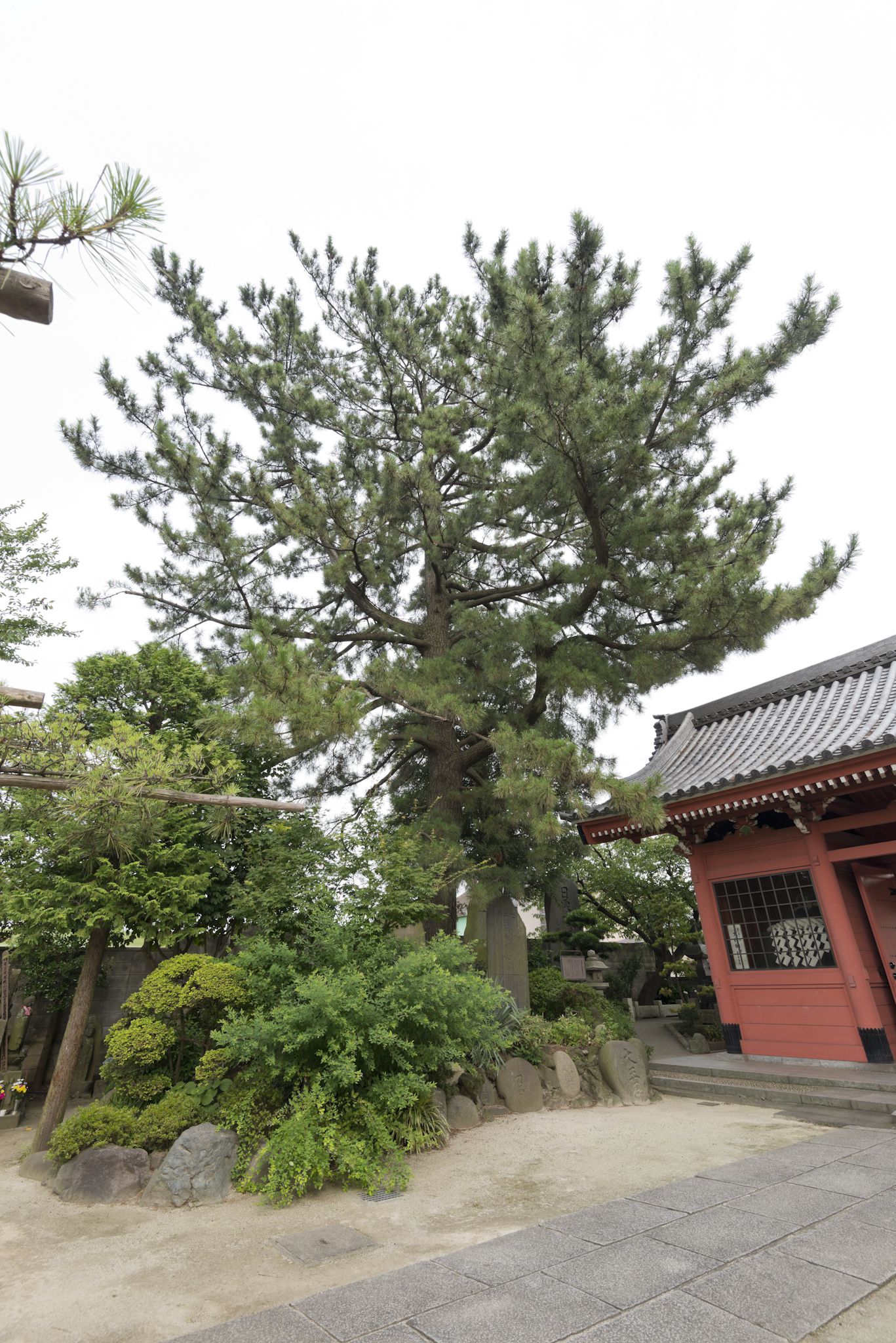Founding ・ History ・ Affiliation
Legend has it that Zenyoji Temple was founded in 1527 during the reign of the twelfth Ashikaga shogun, when Raicho Hoin, the head priest of Daigoji Temple in Kyoto, following guidance received in a vision, carried a treasured statue of the guardian deity Fudo Myoo to this site and erected a building for it. Yet the temple is documented to have existed previously, as the renga poet Socho mentions a visit to Zenyoji in a travel diary published in 1509 ,Azumaji no tsuto. During the Tokugawa period the third shogun Iemitsu (r. 1623-1651) granted the temple a domain producing ten koku of rice and the authority to operate branch temples. Zenyoji has carried forward the teachings of the Buddha ever since, and is currently affiliated with the Buzan Sect of Shingon Buddhism (main temple: Hasedera in Hase, Nara) and governed by Gokokuji Temple in Otowa, Tokyo.
Legend has it that Zenyoji Temple was founded in 1527 during the reign of the twelfth Ashikaga shogun, when Raicho Hoin, the head priest of Daigoji Temple in Kyoto, following guidance received in a vision, carried a treasured statue of the guardian deity Fudo Myoo to this site and erected a building for it. Yet the temple is documented to have existed previously, as the renga poet Socho mentions a visit to Zenyoji in a travel diary published in 1509 ,Azumaji no tsuto. During the Tokugawa period the third shogun Iemitsu (r. 1623-1651) granted the temple a domain producing ten koku of rice and the authority to operate branch temples. Zenyoji has carried forward the teachings of the Buddha ever since, and is currently affiliated with the Buzan Sect of Shingon Buddhism (main temple: Hasedera in Hase, Nara) and governed by Gokokuji Temple in Otowa, Tokyo.
Niomon Gate
The vermilion-painted gate is the main entrance to the temple, facing the Main Hall. It was built in about 1741 and renovated in 1983. The framed calligraphy of the Seijuzan name is in the hand of Gensho, head priest of the Shinjoin subtemple of Ninnaji Temple (the former Omuro Imperial Palace in Kyoto). Standing on either side of the gate are statues of the Nio, the two chief guardians of Buddhism. Behind the statues are the cermonial rope called Daiyokozuna, a gift from the renowned sumo grand champion Tochinishiki who was a native of this district, and a statue of him which was used to make the mold for the statue that stands in JR Koiwa Station.
The vermilion-painted gate is the main entrance to the temple, facing the Main Hall. It was built in about 1741 and renovated in 1983. The framed calligraphy of the Seijuzan name is in the hand of Gensho, head priest of the Shinjoin subtemple of Ninnaji Temple (the former Omuro Imperial Palace in Kyoto). Standing on either side of the gate are statues of the Nio, the two chief guardians of Buddhism. Behind the statues are the cermonial rope called Daiyokozuna, a gift from the renowned sumo grand champion Tochinishiki who was a native of this district, and a statue of him which was used to make the mold for the statue that stands in JR Koiwa Station.
Main Hall
The Main Hall (Hondo) is a wooden structure 14 bays wide and 12 bays deep with a roof of copper sheet. It was rebuilt in 1845. The prinicpal image is a statue of Jizo Bosatsu which is believed to be beneficial for long life, and was brought to Japan by Ryuko, head priest of Chisokuin Temple and pastor to the fifth Tokugawa shogun Tsunayoshi (r. 1680-1709). The framed calligraphy above the main entry, reading Kongojo (place of indestructible truth), is by Gensho whose calligraphy also graces the Niomon Gate.
The Main Hall (Hondo) is a wooden structure 14 bays wide and 12 bays deep with a roof of copper sheet. It was rebuilt in 1845. The prinicpal image is a statue of Jizo Bosatsu which is believed to be beneficial for long life, and was brought to Japan by Ryuko, head priest of Chisokuin Temple and pastor to the fifth Tokugawa shogun Tsunayoshi (r. 1680-1709). The framed calligraphy above the main entry, reading Kongojo (place of indestructible truth), is by Gensho whose calligraphy also graces the Niomon Gate.
Memorial for Mount Asama Volcano Victims
In 1783 on the sixth day of the seventh month (August 3 in the modern calendar) , there was a major eruption of the Mount Asama volcano in the Shinshu region and the pyroclastic flow swept away villages at the base of the mountain, taking the lives of many residents. Along with debris, numerous dead bodies were carried some 200 kilometers down the river Agatsumagawa and into the Tonegawa and then the Edogawa rivers, and the mass of bodies that washed up on a sandbar near the village of Koiwa was so big that it blocked boat traffic on the Edogawa. Deeply struck by the tragic spectacle, the local residents asked the abbot of Zenyoji to hold a memorial ceremony. This memorial stone was placed in 1795 on the thirteenth anniversary of the disaster, and in 1973 was designated a Cultural Property by the government of Tokyo. In 1982, near the 200th anniversary, an additional memorial marker for the Mount Asama inferno was erected as a site for prayers for the victims.
In 1783 on the sixth day of the seventh month (August 3 in the modern calendar) , there was a major eruption of the Mount Asama volcano in the Shinshu region and the pyroclastic flow swept away villages at the base of the mountain, taking the lives of many residents. Along with debris, numerous dead bodies were carried some 200 kilometers down the river Agatsumagawa and into the Tonegawa and then the Edogawa rivers, and the mass of bodies that washed up on a sandbar near the village of Koiwa was so big that it blocked boat traffic on the Edogawa. Deeply struck by the tragic spectacle, the local residents asked the abbot of Zenyoji to hold a memorial ceremony. This memorial stone was placed in 1795 on the thirteenth anniversary of the disaster, and in 1973 was designated a Cultural Property by the government of Tokyo. In 1982, near the 200th anniversary, an additional memorial marker for the Mount Asama inferno was erected as a site for prayers for the victims.
Shikoku Pilgrimage Ground
Eighty-eight small shrines stand on soil brought from each of the eighty-eight temples of the Shikoku pilgrimage circuit associated with Kobo Daishi. Passing through the series is believed to bring the same blessings as the real pilgrimage. Created during the Taisho period (1912-1926).
Eighty-eight small shrines stand on soil brought from each of the eighty-eight temples of the Shikoku pilgrimage circuit associated with Kobo Daishi. Passing through the series is believed to bring the same blessings as the real pilgrimage. Created during the Taisho period (1912-1926).
Hoshikudari Pine (Successor Tree)
When the young Kobo Daishi performed the kokuzo-gumonji practice at Cape Muroto in Kochi, on the last day a brilliant star descended and shone in front of him. When the ninth abbot of Zenyoji, the high priest Kenyu, performed the same practice, likewise on the last day a brilliant star descended and stopped at an old pine tree on the temple grounds. Thereafter, those who witnessed the spectacle called the tree the Hoshikudari Pine (pine of the descending star), and that miracle is the origin of the temple's honorific name Seijuzan (star-dwelling mountain). The descended star is now remembered as the “star energy remains” (Seisei-shari) and the Mitsugon Pagoda on the temple grounds is dedicated to it. The great tree was 600 years old and 30 meters high when it fell during a typhoon in 1940. The successor tree growing strongly in its place was planted in 1953.
When the young Kobo Daishi performed the kokuzo-gumonji practice at Cape Muroto in Kochi, on the last day a brilliant star descended and shone in front of him. When the ninth abbot of Zenyoji, the high priest Kenyu, performed the same practice, likewise on the last day a brilliant star descended and stopped at an old pine tree on the temple grounds. Thereafter, those who witnessed the spectacle called the tree the Hoshikudari Pine (pine of the descending star), and that miracle is the origin of the temple's honorific name Seijuzan (star-dwelling mountain). The descended star is now remembered as the “star energy remains” (Seisei-shari) and the Mitsugon Pagoda on the temple grounds is dedicated to it. The great tree was 600 years old and 30 meters high when it fell during a typhoon in 1940. The successor tree growing strongly in its place was planted in 1953.
